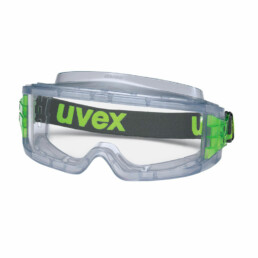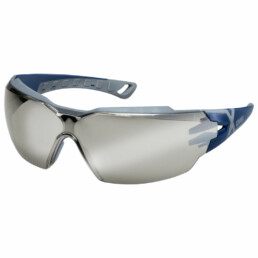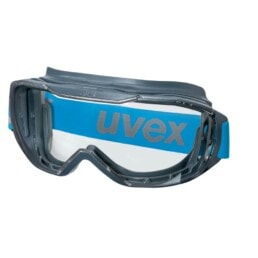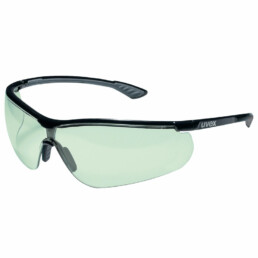What do you think of when you think of personal protective equipment in winter? First and foremost, probably warm clothing, robust footwear and gloves against the cold. But what about safety goggles? Here we list innovative technologies that make your work easier, even in snow and ice.
4,1. 270. 156.
Unfortunately, these are not the lottery numbers for the coming weekend, but the statistical cornerstones of the past winter in Germany: it was 4.1 degrees Celsius cold on average, 270 litres of precipitation fell per square metre and we were granted 156 hours of sunshine. Irrespective of the fact that the first two values were far too high in a long-term comparison, the data from the German Weather Service shows just how challenging the winter is for anyone working outdoors. It’s cold, sometimes even icy, it’s wet, there’s snow and occasionally the sun comes out.
Protect your eyes in cold weather
Given these circumstances, it is hardly surprising that most people dress accordingly during the cold season, both privately and professionally. Nobody would think of stepping out of the door wearing just a T-shirt or flip-flops. You need sensible footwear, warm clothing, gloves and a hat. There are even clear guidelines for the world of work: Regulation 112-189 of the German Social Accident Insurance (DGUV) stipulates that employers must provide their employees with the appropriate equipment to protect them from the wet, wind and cold. At temperatures down to minus five degrees, so-called weather protection clothing is used; at lower temperatures, cold protection clothing must be provided.

The terms ‘eyes’ or ‘safety goggles’ are nowhere to be found in this regulation. Yet our most important sensory organ needs special protection in winter. This is because the drier air – both indoors and outdoors – causes the tear fluid to dry more quickly. It is also important to avoid icy wind blowing into the face. And there is an even greater danger in snow: while the natural green of plants reflects only six per cent of the light in summer, this figure is almost 95 per cent when the sun shines on snow. Without protection against this intense glare, working becomes impossible and the eyes are damaged in the long term. Damage such as conjunctivitis or more serious illnesses, including damage to the retina, can be the result.
uvex: Decades of PPE experience
As a German manufacturer of personal protective equipment, we at uvex have a history of expertise when it comes to professional eye protection. Philipp M. Winter founded the company in 1926 as a one-man business, initially trading in all types of safety eyewear. Today, his grandson Michael Winter manages the almost 100-year-old traditional company, which has long since ceased to specialise solely in eye protection.
Our PPE products now range from head to toe, but this does not diminish our commitment and innovative strength when it comes to safety eyewear. For example, uvex eye protection products are characterised by numerous technologies that are fully effective even in winter conditions.
Anti-fog coating
The uvex supravision coating technology and associated anti-fog coating ensure that the eye protection does not fog up – a problem that every spectacle wearer is familiar with when entering a warm room from the cold. The uvex supravision plus coating provides a remedy by keeping the lenses fog-free on both sides for a very long time (as well as being scratch-resistant). Even after repeated cleaning, the anti-fog effect does not wash out. Thanks to this technology, uvex ultravision goggles, for example, remain fog-free even at minus 30°C and at the same time protect the eye area from icy wind.
Tinting
When working in the snow, we recommend safety spectacles with heavily tinted lenses, such as the uvex pheos cx2 model. With only 12% transmission, it offers very high glare protection in strong sunlight as well as reflection. The additional, optimum signal colour recognition ensures safe and undisturbed vision. Transmission describes the light transmittance, which should be correspondingly low in the case of intense glare and sunlight reflected by snow in order to protect the eyes well. Otherwise there is a risk of snow blindness, which in the worst case can lead to permanent damage.
UV protection
UV protection is a standard feature of all uvex safety spectacles. While the industry standard stipulates protection up to 380 nanometres, we go one step further and guarantee UV protection up to 400 nanometres. This means that uvex products offer complete protection against dangerous UV radiation.
All-round protection with full-vision goggles
To provide your eyes with the best possible protection from unfavourable winter weather conditions such as wind and moisture, it is advisable to wear full-vision goggles with soft, flexible face pads. One such model is the uvex megasonic, whose design is reminiscent of ski goggles. This is certainly no coincidence, as sport is the second major pillar of the uvex group alongside occupational safety. Bicycle, ski and riding helmets are just as much a part of the portfolio as ski goggles. This gives uvex a decisive advantage, as the various subgroups benefit enormously from the transfer of expertise between them – and ultimately also the customers.
uvex variomatic
The uvex variomatic technology is an example of the innovative strength that uvex brings to bear in both worlds. Photochromic lenses react to changing light conditions within seconds and darken continuously with increasing brightness (UV radiation). Or lighten continuously with increasing darkness. What helps skiers on the piste to avoid having to change their goggles several times a day can also be a very convenient feature at work. The uvex sportstyle safety spectacles, among others, offer this technology.
No matter how cold it gets, how much snow falls and how long and intense the sun shines, it is important to adapt your personal protective equipment to the weather conditions. In summer and winter alike.



